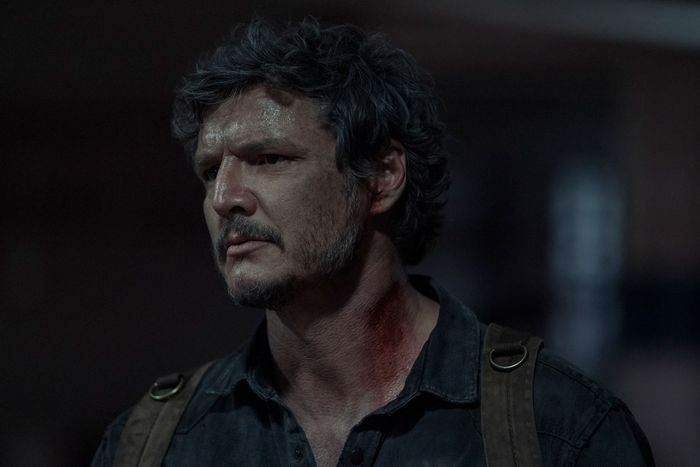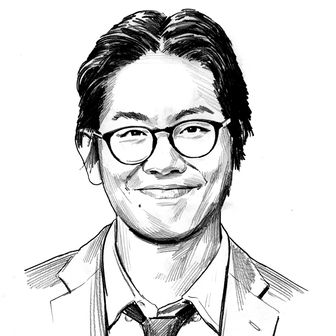
Of the many tweaks made by HBO’s The Last of Us to its source material, the climactic hospital sequence in finale “Look for the Light” is the shrewdest. After surviving a melting pot of horrors, Joel (Pedro Pascal) and Ellie (Bella Ramsey) finally arrive in Salt Lake City, where a Firefly outpost and potential cure await. Of course, a straightforward outcome was never in the cards. Separated from Ellie, Joel is informed that the cost of extracting a vaccine will be her life. Haunted by losing a daughter once before, Joel rejects the situation and slaughters his way through the hospital. When the surgeon resists in the operating theater, Joel instantly shoots him in the face, killing possibly the last person with the necessary expertise to save humanity. Confronted with the trolley problem, Joel bets against the world — and against Ellie’s own autonomy.
In the HBO series, Joel’s shoot-out through the hospital is depicted as a haze. The gaze detaches from his perspective, pulling back to evoke a dreamlike quality. Gustavo Santaolalla’s score swells. Any sense of danger evaporates as we follow Joel reaping carnage through the building almost mechanically. It’s an effective sequence owing, in large part, to its economy: From the moment Joel gains the upper hand over his captors to reach the operating theater, the whole thing only takes about three minutes.
That decision streamlines what, in the source material, feels simultaneously fascinating and tedious. What was so conversation-stirring about this sequence in 2013, beyond the severity of Joel’s decision, was the unique tension between how you may feel about his choice and what you’re made to do in order to beat the game. But as a player, you have to deal with the fact that this narrative climax plays out as what is basically a standard level: As you’ve endured countless times before, you’re made to hide, craft, outmaneuver, bait, and murder in cold blood as you try to reach Ellie before she’s killed. (No smooth thing given that The Last of Us’s combat mechanics were passable at best — even for the era.) And since this is a game, it’s a climax with a fail state: You may die several times trying to reach the operating room, blunting that urgent sense of narrative momentum. The possibility of losing persists even after retrieving Ellie. Mirroring the game’s opening sequence, in which Joel tries to flee the outbreak with an injured Sarah in his arms, you control him carrying Ellie’s unconscious body as he navigates the dangers of armed Fireflies descending on your position.
Much like that opening, you can feel the strain of the game’s elemental storytelling tools in this sequence: Turn the wrong corner or take too much time, and you’re caught and have to start over. There’s a tedium to the interaction being demanded of you coming at some meaningful cost to the narrative momentum. None of that factors into the TV adaptation, which gets to cut straight to the heart of the story’s emotional endgame. The three-minute sequence doesn’t just remain faithful to the original. In some sense, it improves on the experience, actualizing what the game was trying to approximate.
It has been fascinating to watch the TV adaptation of The Last of Us as someone intimately familiar with the original game. To begin with, it has illustrated how differently prestige TV and video games are processed through the cultural economy — I would’ve loved reading so many critical essays about this story back in 2013. But following the TV series in real time has proven illuminating of the possibilities and expectations of any good adaptation. There’s no denying that the HBO series has been a commercial and critical success, an outcome due, in no small part, to how faithful it is to its source material. However, as season one progressed, I couldn’t help wishing for, well, a little less faith.
In terms of adaptational ambition, the HBO series carried a peculiar shape. It was top heavy in the sense that creators Craig Mazin and Neil Druckmann — the latter co-created the game with Bruce Straley — seemed to reserve their biggest expansionary swings for the first half of the season. These were expressed partly by smart, stylish expository scenes — most prominently, the 1960s TV interview at the top of the first episode and the Indonesian lab sequence at the beginning of the second. Such additions widened the aperture of the show, pushing against the sense of claustrophobia that tends to burden postapocalyptic stories. The most inspired of these expansions came in the form of the third episode, “Long, Long Time,” which radically reimagined two peripheral characters from the game and, in doing so, unlocked a new emotional register and thematic depth in the original story. After all, Joel’s decision in the hospital is inextricably linked to the message that Bill (Nick Offerman) imparts in his letter: These are men locked into the same pernicious interpretations of love. It’s just that one had a partner whom he viewed as a true equal to balance him out.
However, as the series passed its halfway point, much of that adaptive ambition seemed to fade away. The Kansas City episodes featured a new narrative factor in the form of Melanie Lynskey’s Kathleen and her band of resistance fighters. Lynskey’s performance was a highlight, but it’s hard to identify anything particularly fresh about the addition, as the group’s ruinous quest for revenge against FEDRA collaborators felt like a minor variation on the show’s preexisting vibe. With the exception of the finale’s opening flashback involving Ellie’s mother Anna (Ashley Johnson, who played Ellie in the game), the subsequent episodes exhibit far less deviation or expansion, sticking close to the original narrative’s shape and beats, right down to the episode “Left Behind,” named for the DLC of the original game. To these episodes’ credit, they do so in a manner that streamlines events to give them more impact in the context of TV storytelling, but by the time we reach Salt Lake City, the show’s handling of the hospital sequence struck me as par for the course. Yes, this would be the right way to adapt this specific moment for TV, but it feels merely procedural: less creative invention and more contained to (gorgeously) realizing the cutscenes and trimming away all of the video-game stuff.
Adaptations always face a natural tension between retaining what was meaningful about the original and breathing new life into an old text. Given the innate quality of the source material, there’s little argument to break away from what’s already there. But the specific peculiarity of The Last of Us lies in the question of how conservative you can get away with being in its adaptation. With the hospital sequence, it’s striking that the adaptation work primarily involves a process of subtraction — compressing time and extracting the narrative climax from what had been a standard shoot-out level in the game. But in hindsight, the very best parts of the HBO series were all of its additions and expansions, making full use of Mazin’s particular gifts as a TV storyteller. It’s not a coincidence that “Long, Long Time” remains the standout episode of the season.
The attention now shifts to adapting The Last of Us Part II. Without giving anything away, the sequel’s story is expansive and wildly ambitious, ultimately turning on a huge structural magic trick. The prospect of watching Bella Ramsey tackle where Ellie goes next is particularly exciting. But The Last of Us Part II feels even more like a sprawling multi-season prestige-TV show than its predecessor does, raising the question of how much room it leaves for further invention. I wouldn’t necessarily mind if all we got was a purely faithful adaptation. But given what the first half of this season showed us, it would be hard not to feel disappointed if that’s all we end up with.





